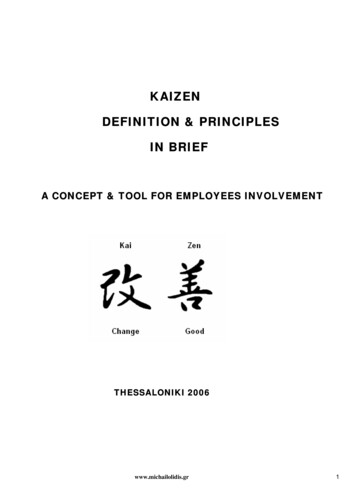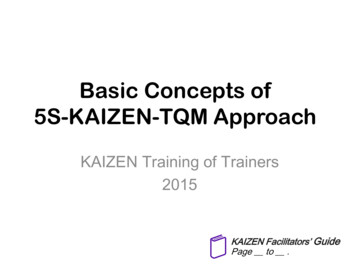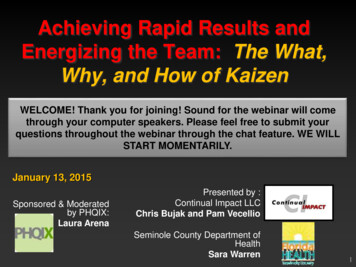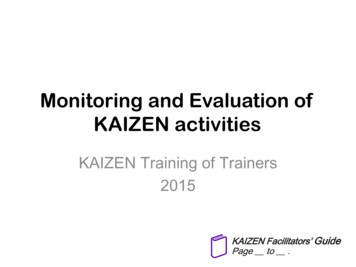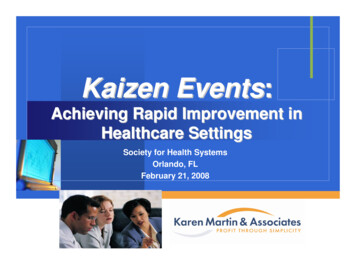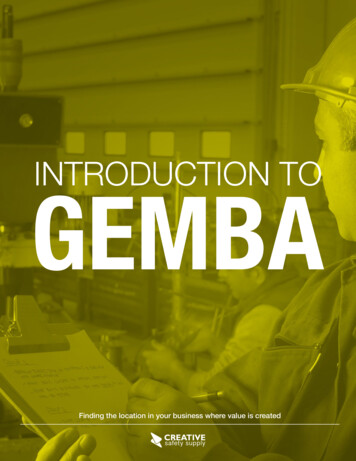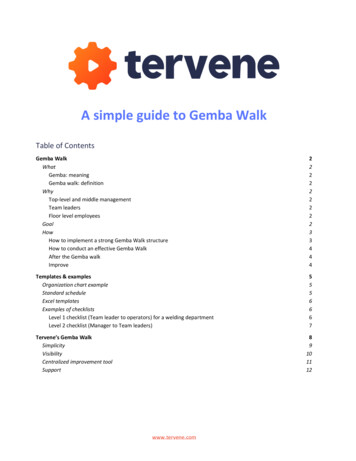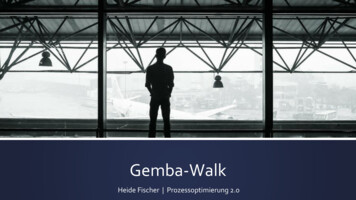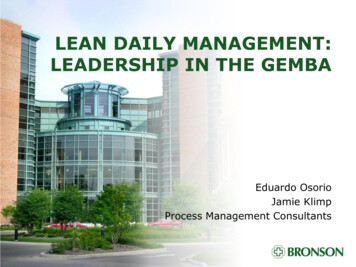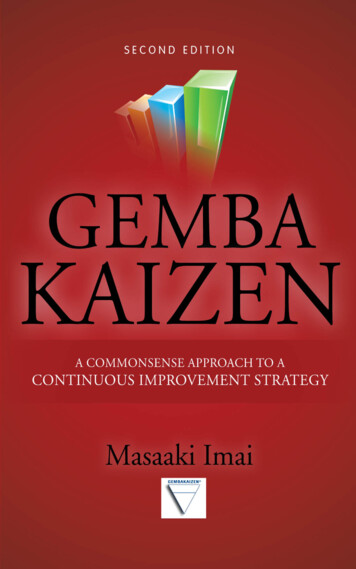
Transcription
Praise for Gemba KaizenIt’s exciting to see an updated version of a classic book, Gemba Kaizen, whichshares a wealth of new healthcare examples and case studies from aroundthe world. A true sensei and master of kaizen, Mr. Imai shares sage andtimeless advice on engaging all team members in process improvementsand radical redesigns which are deeply meaningful to all stakeholders. Themethods in this book will help you improve quality and safety, reducewaiting times, and improve the long-term financial position of yourorganization. Highly recommended!—Mark Graban, author of Lean Hospitalsand co-author of Healthcare KaizenEvery business faces the iron triangle of quality, cost, and delivery.Conventional thinking claims you cannot have all three. Not only does Mr.Imai turn that thinking on its head, but he shows you in Gemba Kaizenexactly how to do it.—Matthew E. May, author of The Elegant Solutionand The Laws of SubtractionMasaaki Imai has done it again. The second edition of his famous bookGemba Kaizen not only describes all the tools necessary for any type ofbusiness to implement a lean strategy but also includes a large number ofexcellent case studies. These show how kaizen can be used to improvehospitals, supermarkets, airport management, a bus line, and even softwaredevelopment. This is a must-read for the leadership of any business.My first exposure to lean [the term hadn’t been invented yet, we calledit Just-in-Time or the Toyota Production System] was at the beginning of1982, during my first General Manager job at the General Electric Company.We created a simple kanban system between one of my plants and one of mysuppliers. We dropped raw material inventory from 40 days to 3 days andgot a lot of unexpected side benefits in the areas of productivity, quality,freed up space, 5S improvements, etc. Professor Schoenburger later did astory on this where he said that this was the first real lean activity at TheGeneral Electric Company. In late 1985 I joined the Danaher Company asone of two Group Executives. One of my company presidents, GeorgeKoenigsaecker, and I began introducing lean to Danaher in 1986. One of
the things that really helped us improve our knowledge of lean at the timewas Masaaki Imai’s first book, Kaizen. This was the most definitive work onthe subject and was a great help. Imai helped us even more in early 1987when he ran a seminar in the Hartford, CT area [just down the street fromJake Brake]. Imai used a Japanese consulting firm, Shingijutsu, to help runhis seminar and be responsible for the hands-on factory kaizen part of theweek. The three principals of Shingijutsu all had spent years working forTaiichi Ohno, the father of the Toyota production system. Koenigsaeckerand I agreed that getting Shingijutsu to help us at Danaher would be a homerun for us and George worked diligently the rest of the week convincingthem. We became their first, and for four years, only American client and ourlean knowledge increased dramatically.In 1991, I left Danaher to become CEO of The Wiremold Company,also in the area. I, of course, brought Shingijutsu along with me and by 1996Masaaki Imai was back in my life as he included a chapter on Wiremoldand what we had done in his new book, Gemba Kaizen. We have stayed intouch over the years and Imai has become a true leader in the leanmovement throughout the world through his Kaizen institute. He clearlyunderstands that lean is a strategy, not just “some manufacturing thing”and that it can apply to any business. He and I have discussed why is it sodifficult for most business leaders to understand this and to embrace lean.Unfortunately there is no simple answer to this other than the fact that mostpeople just don’t like to change and implementing lean is massive change(everything has to change) if you are to be successful. This latest edition ofGemba Kaizen goes a long way to helping to solve this problem. First of all,it lays out the lean philosophy and tools in a very simple way so thatexecutives should not only understand them but more importantly, not beafraid to try them. More importantly however, Imai makes the case thatlean is a strategy and that it can be applied to any business. His case studiesof non-manufacturing companies where lean has had a dramatic impactreally help to make the point. Every leader of any type of organizationshould read this book and follow what it says.—Art Byrne, Operating Partner at J W Childs Associates, LPand author of The Lean Turnaround
Gemba Kaizen
About the AuthorMore than any other business authority in the world, Masaaki Imai haschampioned the concept of kaizen over the past three decades in thought,word, and action. Mr. Imai is considered one of the leaders of the qualitymovement and a pioneer of modern business operational excellence. Mr.Imai is an international lecturer, consultant, and founder of the KaizenInstitute, a leading continuous improvement consultancy with officesworldwide. Mr. Imai’s first book, Kaizen—translated into 14 languages—isthe reference on the subject. Gemba Kaizen picks up where Kaizen left off,introducing real-world application of continuous process improvementmethods in production and service businesses. The second edition is fullyrevised with brand-new case studies, updated chapters, and currentreferences. In 2010 Mr. Imai was honored for his lifetime of achievementwith the first ever Fellowship of the Quality Council of India, the apexquality body of the government of India.
Gemba KaizenA Commonsense Approach to aContinuous Improvement StrategyMasaaki ImaiSecond EditionNew York Chicago San FranciscoLisbon London Madrid Mexico CityMilan New Delhi San JuanSeoul Singapore Sydney Toronto
Copyright 2012, 1997 by the Kaizen Institute, Ltd. All rights reserved. Except as permitted under theUnited States Copyright Act of 1976, no part of this publication may be reproduced or distributed inany form or by any means, or stored in a database or retrieval system, without the prior written permission of the publisher.ISBN: 978-0-07-179036-9MHID: 0-07-179036-5The material in this eBook also appears in the print version of this title: ISBN: 978-0-07-179035-2,MHID: 0-07-179035-7.All trademarks are trademarks of their respective owners. Rather than put a trademark symbol afterevery occurrence of a trademarked name, we use names in an editorial fashion only, and to the benefitof the trademark owner, with no intention of infringement of the trademark. Where such designationsappear in this book, they have been printed with initial caps.McGraw-Hill eBooks are available at special quantity discounts to use as premiums and salespromotions, or for use in corporate training programs. To contact a representative please e-mail us atbulksales@mcgraw-hill.com.KAIZEN and GEMBA KAIZEN are trademarks of Kaizen Institute, Ltd.Information contained in this work has been obtained by The McGraw-Hill Companies, Inc.(“McGraw-Hill”) from sources believed to be reliable. However, neither McGraw-Hill nor its authorsguarantee the accuracy or completeness of any information published herein, and neither McGraw-Hillnor its authors shall be responsible for any errors, omissions, or damages arising out of use of thisinformation. This work is published with the understanding that McGraw-Hill and its authors aresupplying information but are not attempting to render engineering or other professional services. Ifsuch services are required, the assistance of an appropriate professional should be sought.TERMS OF USEThis is a copyrighted work and The McGraw-Hill Companies, Inc. (“McGraw-Hill”) and itslicensors reserve all rights in and to the work. Use of this work is subject to these terms. Except aspermitted under the Copyright Act of 1976 and the right to store and retrieve one copy of the work, youmay not decompile, disassemble, reverse engineer, reproduce, modify, create derivative works basedupon, transmit, distribute, disseminate, sell, publish or sublicense the work or any part of it withoutMcGraw-Hill’s prior consent. You may use the work for your own noncommercial and personal use;any other use of the work is strictly prohibited. Your right to use the work may be terminated if you failto comply with these terms.THE WORK IS PROVIDED “AS IS.” McGRAW-HILL AND ITS LICENSORS MAKE NOGUARANTEES OR WARRANTIES AS TO THE ACCURACY, ADEQUACY ORCOMPLETENESS OF OR RESULTS TO BE OBTAINED FROM USING THE WORK,INCLUDING ANY INFORMATION THAT CAN BE ACCESSED THROUGH THE WORKVIA HYPERLINK OR OTHERWISE, AND EXPRESSLY DISCLAIM ANY WARRANTY,EXPRESS OR IMPLIED, INCLUDING BUT NOT LIMITED TO IMPLIED WARRANTIES OFMERCHANTABILITY OR FITNESS FOR A PARTICULAR PURPOSE. McGraw-Hill and itslicensors do not warrant or guarantee that the functions contained in the work will meet yourrequirements or that its operation will be uninterrupted or error free. Neither McGraw-Hill nor itslicensors shall be liable to you or anyone else for any inaccuracy, error or omission, regardless of cause,in the work or for any damages resulting therefrom. McGraw-Hill has no responsibility for the contentof any information accessed through the work. Under no circumstances shall McGraw-Hill and/orits licensors be liable for any indirect, incidental, special, punitive, consequential or similar damagesthat result from the use of or inability to use the work, even if any of them has been advised of thepossibility of such damages. This limitation of liability shall apply to any claim or cause whatsoeverwhether such claim or cause arises in contract, tort or otherwise.
CONTENTSPreface . . . . . . . . . . . . . . . . . . . . . . . . . . . . . . . . . . . . . . . xiiiAcknowledgments . . . . . . . . . . . . . . . . . . . . . . . . . . . . . xviiAbout Kaizen Institute. . . . . . . . . . . . . . . . . . . . . . . . . . . xixCHAPTER 1An Introduction to Kaizen . . . . . . . . . . . . . . . . . . . . . 1Major Kaizen Concepts . . . . . . . . . . . . . . . . . . . . . . . . . . . 2Kaizen and Management . . . . . . . . . . . . . . . . . . . . . 3Process versus Result . . . . . . . . . . . . . . . . . . . . . . . . . 4Following the PDCA/SDCA Cycles . . . . . . . . . . . . . . 4Putting Quality First . . . . . . . . . . . . . . . . . . . . . . . . . 6Speak with Data . . . . . . . . . . . . . . . . . . . . . . . . . . . . 7The Next Process Is the Customer . . . . . . . . . . . . . . . 7Major Kaizen Systems . . . . . . . . . . . . . . . . . . . . . . . . . . . . 7Total Quality Control/Total Quality Management. . 8The Just-in-Time Production System . . . . . . . . . . . . 8Total Productive Maintenance . . . . . . . . . . . . . . . . . . 9Policy Deployment . . . . . . . . . . . . . . . . . . . . . . . . . . . 9The Suggestion System . . . . . . . . . . . . . . . . . . . . . . . 10Small-Group Activities . . . . . . . . . . . . . . . . . . . . . . 10The Ultimate Goal of Kaizen Strategy . . . . . . . . . . . . . . 11CHAPTER 2Gemba Kaizen . . . . . . . . . . . . . . . . . . . . . . . . . . . . . . . . 13Gemba and Management . . . . . . . . . . . . . . . . . . . . . . . . 14The House of Gemba . . . . . . . . . . . . . . . . . . . . . . . . . . . . 19Standardization . . . . . . . . . . . . . . . . . . . . . . . . . . . . . . . . . 19The Five S (5S) of Good Housekeeping . . . . . . . . . . . . . 21Muda Elimination . . . . . . . . . . . . . . . . . . . . . . . . . . . . . . 21The Golden Rules of Gemba Management . . . . . . . . . . 23Go to the Gemba First . . . . . . . . . . . . . . . . . . . . . . . 24Check the Gembutsu . . . . . . . . . . . . . . . . . . . . . . . . 28Take Temporary Countermeasures on the Spot . . . 29vii
viii ContentsFind the Root Cause . . . . . . . . . . . . . . . . . . . . . . . . . 30Standardize to Prevent Recurrence . . . . . . . . . . . . . 31Application of the Golden Rules . . . . . . . . . . . . . . . . . . 33CHAPTER 3Quality, Cost, and Delivery at the Gemba. . . . . . . 37Quality: More Than Just a Result . . . . . . . . . . . . . . . . . . 37Quality Management at the Gemba . . . . . . . . . . . . . . . . 40Cost Reduction at the Gemba . . . . . . . . . . . . . . . . . . . . . 44Improve Quality . . . . . . . . . . . . . . . . . . . . . . . . . . . . 45Improving Productivity to Lower Costs . . . . . . . . . . 45Reduce Inventory . . . . . . . . . . . . . . . . . . . . . . . . . . . 45Shorten the Production Line . . . . . . . . . . . . . . . . . . 46Reduce Machine Downtime . . . . . . . . . . . . . . . . . . 46Reduce Space . . . . . . . . . . . . . . . . . . . . . . . . . . . . . . 47Reduce Lead Time (Throughput Time) . . . . . . . . . 47Role of the Gemba in Overall Cost Reduction . . . . 48Delivery . . . . . . . . . . . . . . . . . . . . . . . . . . . . . . . . . . . . . . . 48Quality Improvement and Cost ReductionAre Compatible . . . . . . . . . . . . . . . . . . . . . . . . . . . . . . 49CHAPTER 4Standards . . . . . . . . . . . . . . . . . . . . . . . . . . . . . . . . . . . . 51Maintain and Improve Standards . . . . . . . . . . . . . . . . . . 51Operational Standards . . . . . . . . . . . . . . . . . . . . . . . . . . . 53Key Features of Standards . . . . . . . . . . . . . . . . . . . . . . . . 54Toyoda Machine Works . . . . . . . . . . . . . . . . . . . . . . . . . . 57The Kaizen Story . . . . . . . . . . . . . . . . . . . . . . . . . . . . . . . 57The Toyota Business Practice: The StandardProblem-Solving Story at Toyota . . . . . . . . . . . . . . . . 58Kaizen and International Quality Standards . . . . . . . . . 61CHAPTER 5The 5S: The Five Steps of WorkplaceOrganization . . . . . . . . . . . . . . . . . . . . . . . . . . . . . . . . . 65Good Housekeeping in Five Steps . . . . . . . . . . . . . . . . . 665S for the City: Civic Pride in Romania . . . . . . . . . . . . . 67A Detailed Look at the Five Steps of 5S . . . . . . . . . . . . . 69Seiri (Sort) . . . . . . . . . . . . . . . . . . . . . . . . . . . . . . . . 70
Contents ixSeiton (Straighten) . . . . . . . . . . .
Gemba Kaizennot only describes all the tools necessary for any type of business to implement a lean strategy but also includes a large number of excellent case studies. These show how kaizen can be used to improve hospitals, supermarkets, airport management, a bus line, and even software development. This is a must-read for the leadership of any business. My first exposure to lean [the term .File Size: 371KBPage Count: 35

